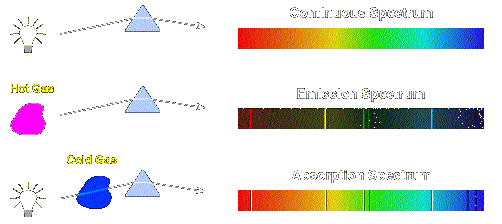The Solution to Cosmic Crime: Chemical Fingerprinting
In
order to understand chemical fingerprinting, one must first understand the Bohr
Atomic Model and the concept of discrete electron energy levels. Although the Bohr
model is now proven to not be entirely correct, it is essential for
understanding the cosmic clues that are both emission and absorption lies, as
well as the chemical fingerprints of cosmic entities.
 |
| http://astro.unl.edu/naap/hydrogen/graphics/bohr_transitions.png |
The Bohr Atomic model shows us that every element, ion, and molecule is
endowed with a unique and specific set of discrete energy levels. These discrete
energy levels, along the electromagnetic spectrum, cause the appearance of both
emission and absorption lines. When an electron gains enough energy to move
from a lower energy level to a higher energy level, we witness absorption
lines. Inversely, when an electron “drops” energy levels, it emits a photon
with a wavelength equivalent to the difference in energy between the orbital in
which it started and the orbital that it moves to: and emission line. An
emission spectrum occurs when viewing a hot, diffuse gas through a prism, and
an absorption spectrum occurs when viewing a cold (in comparison the objects
around it) gas.
 |
| http://www.pas.rochester.edu/~blackman/ast104/spectra2.gif |
As elements interact with photons, in a multitude of different ways within
the vastness of the universe, the electrons possessed by individual atoms
exchange energy to enable an electron to move from a low energy electron shell
to a shell with a different and greater energy. However, when that same
electron returns to a low energy electron shell, energy is released in the form
of a photon with specific wavelength equal to the differences in energy—much the
same as a bank robber leaves a fingerprint or a trace of DNA after interacting
with something in their surroundings. The photon MUST contain the same amount
of energy that electron lost—due to the Law of Conservation of Energy—which
means that the photon will also has the same specific wavelength exclusive and
unique to the element from which it was released. Because of this fact, it is
difficult for any element, molecule, or ion to remain hidden among the cosmos
(atomic criminals beware!).
From this information obtained by observing
elements on Earth, scientists were able to create a, proverbial, Chemical
Identification Database, used to identify any unruly, or criminal, matter on
Earth or in space. Additionally, the information
gained enabled scientists to determine two things. Firstly, that chemical fingerprinting
could be done with other elements, ions, and molecules. Secondly, that it could
be done with distance objects in the universe. chemical fingerprinting has also
explained the markings scientists have observed when looking at distant objects
through telescopes—each element leaves a spectral “fingerprint”, in the
electromagnetic spectrum.
 |
| http://www.edhat.com/2014_media/Edhat_Solar_Spectrum.jpg |
However, before they
were able to understand the meaning of these cosmic “fingerprints”, scientists
conducted many laboratory experiments to determine the spectral lines (emission
and absorption) of all elements on the periodic table—in addition to many
common ions and molecules. Thus, when any spectral lines are observed in a
distant object—alone or in conjunction with other lines—the chemical
composition of such an object can be determined and cosmic crimes can be solved.
Modern scientific advancements and careful analysis have also enabled
scientists to accurately predict the quantities and proportions of which elements
exist in objects being observed (Criminals, we know who you are working with).
 |
| http://www.umop.net/spctelem.png |
Chemical fingerprinting
has enabled scientists to prove that the universe, in its entirety, is
constructed of the same elements found here on Earth and discover the
composition of distant objects. Chemical fingerprinting also has many practical
applications in modern Astronomy (and Universal Forensics). An understanding of
the composition of other stars, planets, comets, and other cosmic objects has
been essential in the search for other forms of life in the universe. Though
determining the chemical fingerprint of the “building blocks” essential to
life, astronomers have narrowed their search for life among the stars. chemical
fingerprinting has proved itself to be essential in determining the composition
of the universe and the possibilities for future exploration, created by the
technique, are endless—making chemical fingerprinting truly invaluable to the
field of Astronomy. As scientists continue to search for clues about the
mysteries of the universe, chemical fingerprinting will be essential in
discovering the sometimes “criminal” happenings of matter and energy in the
cosmos.

No comments:
Post a Comment